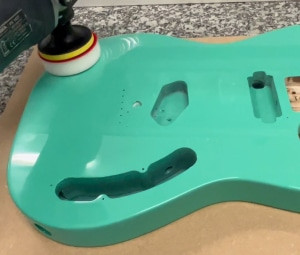Painting a guitar is a fantastic way to personalize your instrument, breathe new life into an old favorite, or even embark on a rewarding DIY project. While it might seem daunting, painting a guitar for a professional-looking finish is absolutely achievable with the right guidance and a bit of patience. This comprehensive guide will walk you through each step of the process, from preparing the wood to applying the final clear coat, ensuring you achieve a stunning and durable finish. We’ll focus on using commonly available nitrocellulose spray paints and varnishes, the go-to choice for many guitar enthusiasts and professionals.
Before diving into the painting process, it’s crucial to properly disassemble your guitar. This ensures every part is accessible for painting and avoids unwanted paint on components that shouldn’t be coated. If you’re unsure how to do this, it’s recommended to consult a guide on how to disassemble a guitar correctly before proceeding.
Essential Materials for Painting Your Guitar
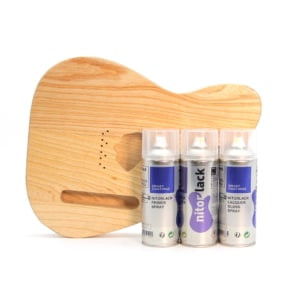 pintar guitarra desde cero
pintar guitarra desde cero
To follow this guide and achieve a professional guitar paint job, you’ll need to gather the following materials:
- Fine-grit sandpaper (800-grit, 1200-grit, 1500-grit, 2000-grit)
- Tack cloth
- Nitorlack Primer (or similar guitar-specific primer)
- Guitar paint spray cans (your chosen color)
- Nitorlack Varnish / Nitorlack Golden Age (or similar nitrocellulose lacquer)
- Mirka Polarshine 10 & 5 polishing compounds (or equivalent)
- Polishing sponges (white and black)
- Microfiber cloths
- Optional: Grain filler (for open-pore woods like mahogany or ash)
Step-by-Step Guide to Painting Your Guitar Professionally
Phase 1: Sealing the Wood Pores and Applying Primer
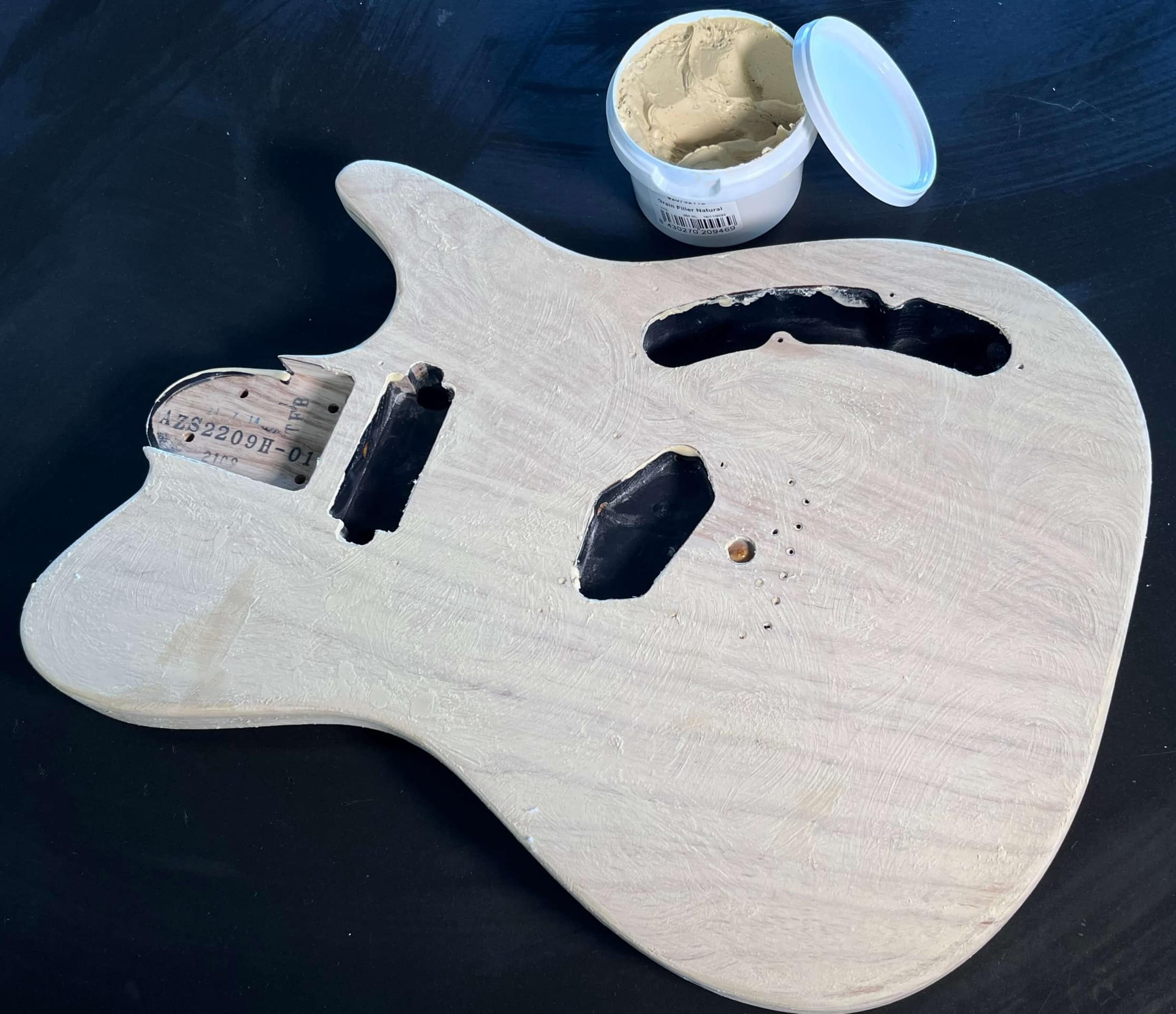 cubrir poro madera
cubrir poro madera
Properly sealing the wood pores is a foundational step for a smooth and flawless finish. This prevents the paint and varnish from sinking into the wood grain, which would require more coats and potentially lead to an uneven surface.
If you’re working with an open-pore wood like mahogany or ash, using a grain filler is highly recommended. For tighter-grained woods like alder or maple, this step is less critical and can be skipped, though using a primer is still essential.
- Applying Grain Filler (for open-pore woods): Mix the water-based grain filler with water to create a paste-like consistency. Apply this paste to the guitar body, working it into the pores with a cloth or spatula. After a few minutes, clean off the excess and sand lightly once dry.
- Applying Primer: Whether you’ve used grain filler or not, primer is crucial. Apply Nitorlack Primer in thin coats using smooth, even strokes. Sand lightly with 800-grit sandpaper between coats to remove any imperfections. Repeat this process until you have a smooth, even surface free of any visible wood grain or imperfections. Typically, 2-3 coats are sufficient if you’ve used grain filler; otherwise, you might need a few more.
- Final Sanding: Finish the priming phase by sanding the entire surface with 800-grit sandpaper. The goal is to create a perfectly smooth base ready for the color coat. Use a tack cloth to remove any sanding dust before moving to the next phase.
Phase 2: Applying the Color Coat
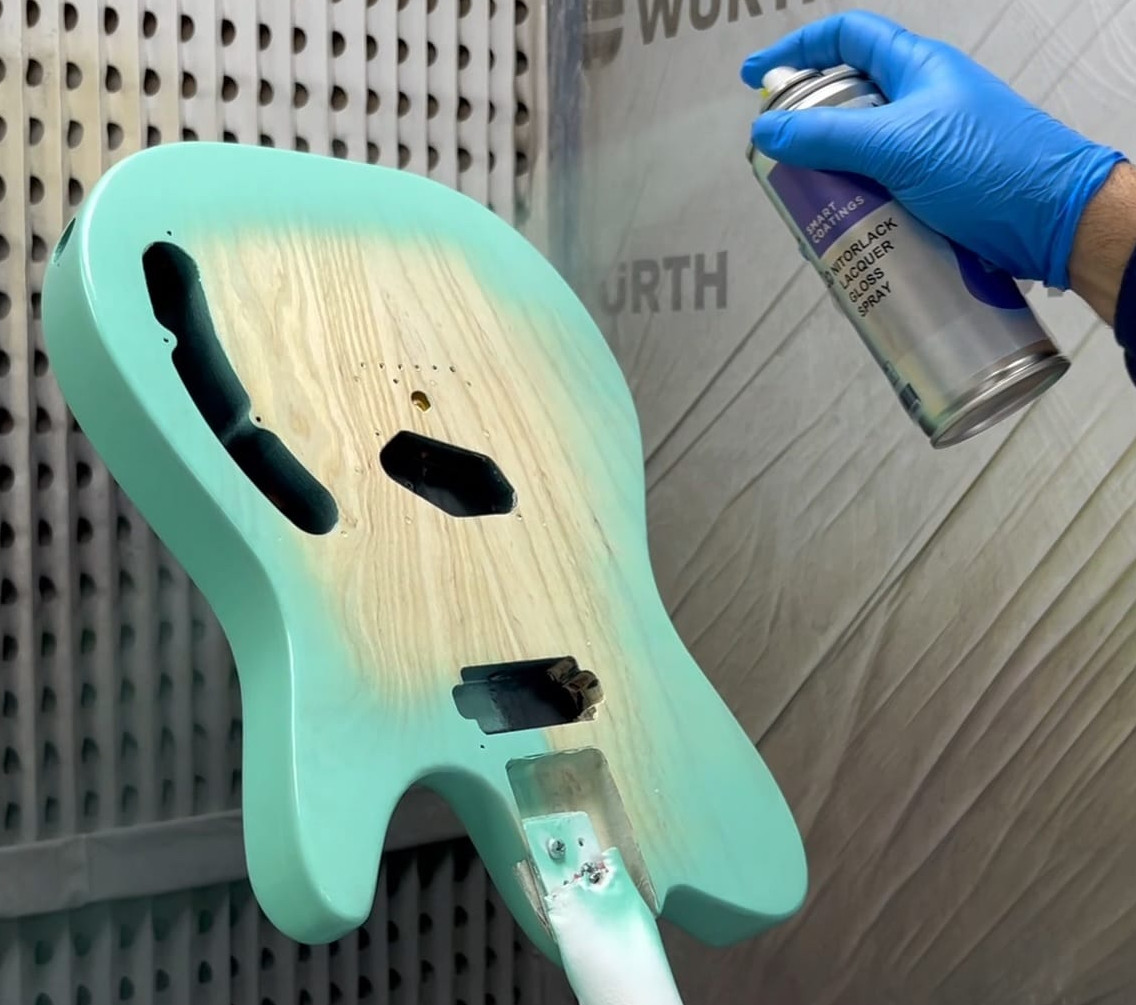 aplicación de la pintura
aplicación de la pintura
With the surface primed and smooth, it’s time to apply the color. Whether you’re using spray cans or a paint spray gun, the technique remains similar. Spray cans are convenient for DIY projects and can deliver excellent results when used correctly.
- Spray Technique: Begin by painting the edges of the guitar body, then move to the front and back surfaces. Apply the paint in thin, even coats using linear, overlapping strokes. Maintain a consistent distance of approximately 25 cm (10 inches) from the guitar surface to avoid runs or uneven application.
- Multiple Thin Coats: It’s always better to apply several thin coats rather than one thick coat. Thin coats dry faster and are less prone to drips and runs. Allow at least 12 hours of drying time between coats to ensure proper and uniform drying from the initial layer.
- Sanding Between Coats: Between each color coat, lightly sand with 800-grit sandpaper to remove any minor imperfections or dust particles that may have settled on the surface. This ensures a perfectly smooth base for subsequent coats and the final clear coat.
- Achieving Full Coverage: Continue applying thin coats of color until the entire guitar surface is uniformly covered and the desired color depth is achieved. The number of coats will vary depending on the paint’s opacity and your desired finish.
- Final Sanding (Color Coat): Once you’re satisfied with the color coverage, perform a final light sanding with 800-grit sandpaper to prepare for the clear coat application. Again, remove all dust with a tack cloth.
Phase 3: Applying the Clear Coat Finish
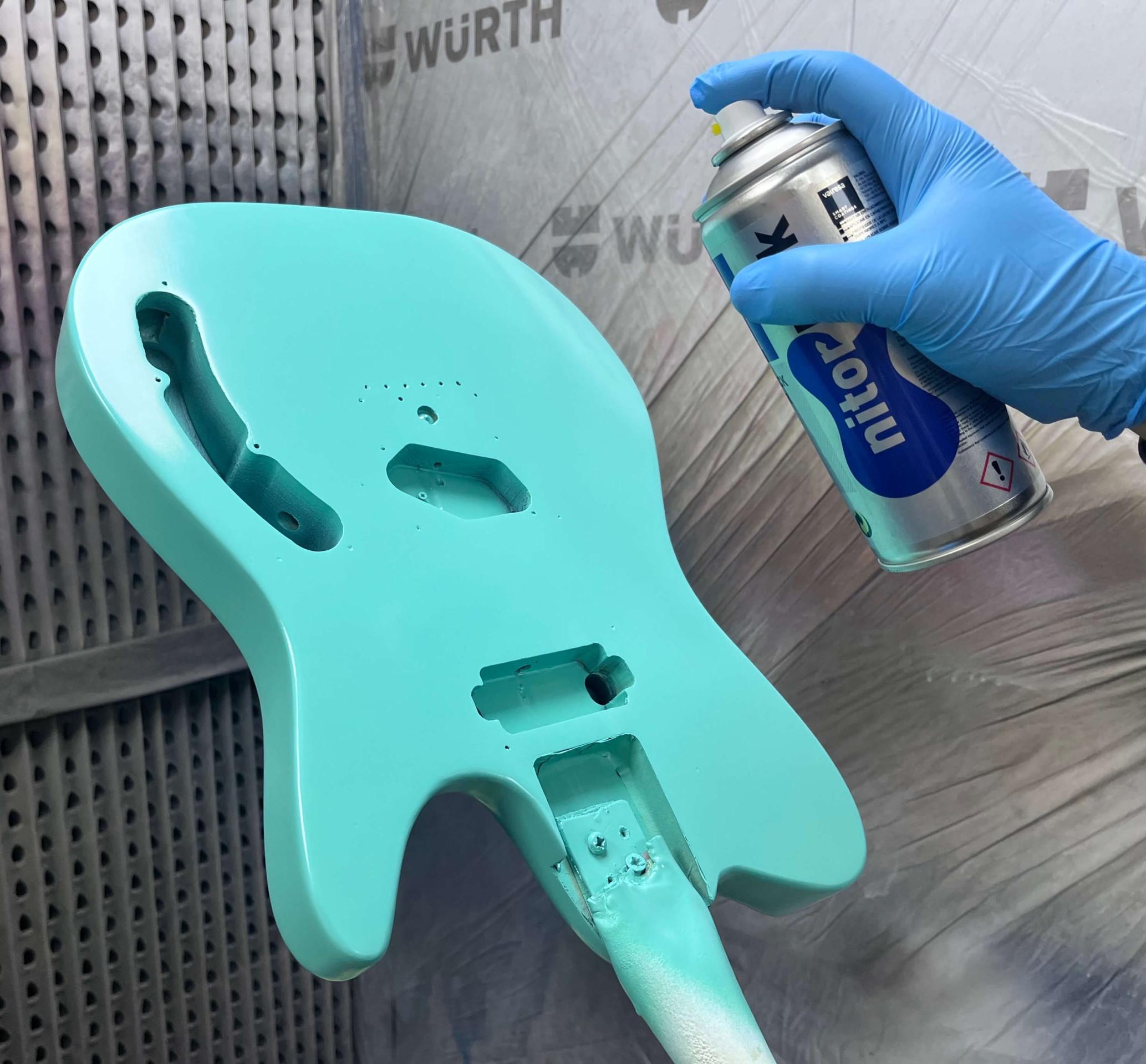 pintando una guitarra
pintando una guitarra
The clear coat, typically a nitrocellulose lacquer like Nitorlack Lacquer or Golden Age, is crucial for protecting the color coat and providing the final gloss and depth to the finish. This phase requires the same attention to detail as the color coat application.
- Application Technique: Follow the same spraying techniques used for the color coat: thin, even coats, linear strokes, and a distance of approximately 25 cm.
- Environmental Conditions: Ensure you are working in a clean, dry environment with good ventilation. Avoid high humidity and extreme temperatures. Ideal temperatures are between 15°C and 30°C (59°F and 86°F). Unfavorable conditions can negatively impact the lacquer’s drying and curing process, potentially leading to clouding or other finish defects.
- Number of Clear Coats: Apply at least 3 to 4 coats of clear lacquer to build sufficient protection and depth. Sand lightly with 800-grit sandpaper between coats to ensure a smooth, even build-up and remove any imperfections.
- Drying Time: Allow at least 12 hours of drying time between each clear coat application. Proper drying is essential for preventing solvent entrapment and ensuring a hard, durable finish.
Phase 4: Level Sanding and Polishing (Optional, but Highly Recommended)
Even with careful application, minor imperfections like dust particles or slight orange peel texture can appear in the clear coat. Level sanding and polishing are essential steps to achieve a truly professional, mirror-like gloss.
- Curing Time: Crucially, allow the final clear coat to cure completely for at least 21 days before beginning sanding and polishing. This ensures the nitrocellulose lacquer is fully hardened and ready for the leveling process.
- Level Sanding: Begin with 800-grit sandpaper and progressively move through 1200-grit, 1500-grit, and finally 2000-grit sandpaper. You can perform this sanding process either dry or wet (with water and a drop of soap as a lubricant). The goal is to level the surface, removing any imperfections and creating a uniformly smooth, matte finish. Watch for shiny spots during sanding – these indicate low areas that still need to be leveled. Be careful not to sand through the clear coat into the color coat.
- Polishing: Once the surface is uniformly matte and sanded to 2000-grit, it’s time to polish. Use Mirka Polarshine 10 with a white polishing sponge to remove the 2000-grit sanding marks and begin bringing up the gloss. Follow this with Mirka Polarshine 5 and a black polishing sponge for an even higher gloss and to eliminate any potential holograms or swirl marks.
- Final Cleaning: Gently clean the polished surface with a microfiber cloth to remove any polishing residue. You should now have a stunning, mirror-like finish.
Phase 5: Guitar Aging or Relicing (Optional)
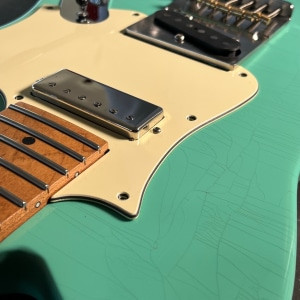 como pintar una guitarra
como pintar una guitarra
For those seeking a vintage, played-in look, aging or relicing the guitar finish is an optional final step. This process simulates the natural wear and tear that a guitar finish accumulates over decades.
- Simulating Wear: Before inducing lacquer cracks, you can create subtle “war wounds” by lightly tapping or creating small indentations on the finish to mimic the natural wear from playing. This can influence the direction and realism of the lacquer cracks.
- Temperature Cracking (Crazing): The classic method for creating lacquer cracks (checking) involves temperature changes. Place the guitar in a freezer at -20°C (-4°F) for 12-24 hours. The cold temperature will cause the wood to contract, while the less flexible nitrocellulose lacquer will crack.
- Highlighting Cracks: Immediately after removing the guitar from the freezer, the cracks will be more open and pronounced. Use this opportunity to highlight them. Apply a thin wash of water-based dye or bitumen of Judea to the surface and then quickly wipe away the excess with a cloth. This will leave the dye or bitumen in the cracks, making them visually prominent and enhancing the aged appearance.
- Repeat for More Cracking: If you desire more extensive checking, you can repeat the freeze-thaw cycle multiple times.
By following these steps diligently, you can achieve a professional-quality paint job on your guitar. Remember that patience and attention to detail are key. With practice and the right techniques, you can transform your guitar into a uniquely personalized instrument. For further visual guidance, many video tutorials online demonstrate these guitar painting techniques. And if you have any further questions, don’t hesitate to seek out personalized support from guitar finishing experts.

